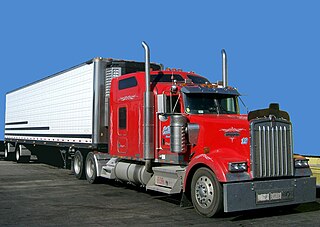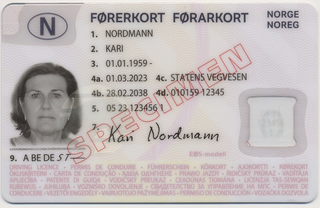
An L-plate is a square plate bearing a sans-serif letter L, for learner, which must be affixed to the front and/or back of a vehicle in many countries if its driver is a learner under instruction, or a motorcycle rider with provisional entitlement to ride restricted motorcycles.

A commercial driver's license (CDL) is a driver's license required in the United States to operate large and heavy vehicles or a vehicle of any size that transports hazardous materials or more than 15 passengers.
Graduated driver licensing systems (GDLS) are designed to provide new drivers of motor vehicles with driving experience and skills gradually over time in low-risk environments. There are typically three steps or stages through which new drivers pass. They begin by acquiring a learner's permit, progress to a restricted, probationary or provisional license, followed by receipt of a full driver's license. Graduated drivers' licensing generally restricts nighttime, expressway, and unsupervised driving during initial stages, but lifts these restrictions with time and further testing of the individual, eventually concluding with the individual attaining a full driver's license.
A driver's permit, learner's permit, learner's license or provisional license is a restricted license that is given to a person who is learning to drive, but has not yet satisfied the prerequisite to obtain a driver's license. Having a learner's permit for a certain length of time is usually one of the requirements for applying for a full driver's license. To get a learner's permit, one must typically pass a written permit test, take a basic competency test in the vehicle, or both.

Driver licences in Australia refer to the official permit required for a person to legally drive a motor vehicle in Australia. The issue of driver licences, alongside the regulation and enforcement of road use, are all managed by state and territory governments.
In Canada, driver's licences are issued by the government of the province or territory in which the driver is residing. Thus, specific regulations relating to driver's licences vary province to province, though overall they are quite similar. All provinces have provisions allowing non-residents to use licences issued by other provinces and territories, out-of-country licences, and International Driving Permits. Many provinces also allow non-residents to use regular licences issued by other nations and countries. Canadian driver's licences are also valid in many other countries due to various international agreements and treaties.
In India, a driving licence is an official document that authorises its holder to operate various types of motor vehicles on highways and some other roads to which the public has access. In various Indian states, they are administered by the Regional Transport Authorities/Offices (RTA/RTO). A driving licence is required in India by any person driving a vehicle on any highway or other road defined in the Motor Vehicles Act, 1988. This act sets limits on the minimum age for vehicle operation ranging from 16 to 20, depending on specific circumstances. A modern photo of the driving licence can also serve many of the purposes of an identity card in non-driving contexts, such as proof of identity or age.
The New Zealand driver licence system is a graduated system that has been in place since 1988. It consists of three phases for a car licence, each with varying levels of conditions.

In Finland, a driver's licence can be obtained either in a private driving school or given by a relative with a driving instruction permit.

Norwegian driving licences adhere to a standard set in the European Economic Area.

Swedish driving licences adhere to a standard set in the European Economic Area. 18 years is the minimum age to obtain a licence for cars.

In Romania, the driving licence is a governmental right given to those who request a licence for any of the categories they desire. It is required for every type of motorized vehicle. The minimum age to obtain a driving licence is 18 years. Regardless of age, in the first year after obtaining the licence the driver is called a beginner and has to display on the windscreen and the back window of the car the distinctive sign.
The Driver Certificate of Professional Competence (Driver CPC) is a qualification for professional bus, coach and lorry drivers. It has been introduced across Europe with the aim of improving road safety and maintaining high standards of driving.
The UK practical motorcycle tests consist of a practical test of two modules. To first ride on the road, a candidate must complete Compulsory Basic Training, however, there is no test.

In Mexico, it is each state's responsibility to regulate driving in their respective jurisdiction, and therefore each state issues their own driving licence. Drivers need to demonstrate residence in most states in order to acquire that state's licence, although some offer visitor licenses. All states recognise each other's licence.

Driving licence in Thailand is a document that allows the holder to drive on any roads in the Kingdom of Thailand. The minimum age to drive a motor vehicle is 18, and to drive a motorcycle is 15. Driving licence is issued and administered by the Department of Land Transport, Ministry of Transport and its branches, land transport offices across Thailand.

A driver's license, driving licence, or driving permit is a legal authorization, or the official document confirming such an authorization, for a specific individual to operate one or more types of motorized vehicles—such as motorcycles, cars, trucks, or buses—on a public road. Such licenses are often plastic and the size of a credit card.

In Germany, the driving licence ("Führerschein") is a governmental privilege given to those who request a licence for any of the categories they desire. It is required for every type of motorised vehicle with the exception of the smallest mopeds below 50 cm³, with a speed limit of 25 km/h, as well as motorised bicycles. The types of licences one may obtain are the same in all the European Economic Area. See European driving licence.

In Italy, the driving licence is a governmental right given to those who request a licence for any of the categories they choose. It is required for every type of motorized vehicle.

In Greece, driving licences are a governmental documents given to those who request a licence to drive and meet set requirements.












